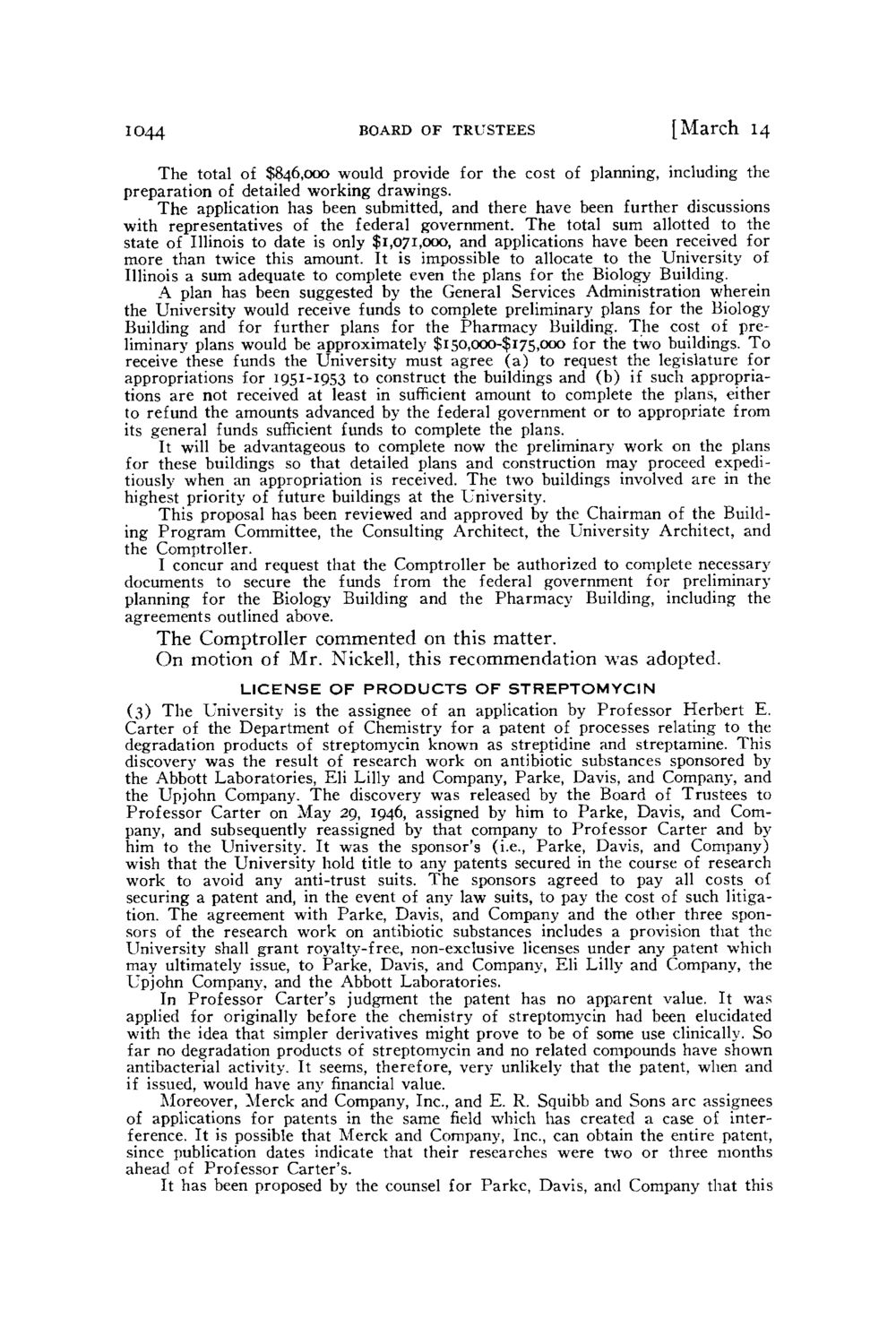| |
| |
Caption: Board of Trustees Minutes - 1950
This is a reduced-resolution page image for fast online browsing.

EXTRACTED TEXT FROM PAGE:
1044 BOARD OF TRUSTEES [March 14 The total of $846,000 would provide for the cost of planning, including the preparation of detailed working drawings. The application has been submitted, and there have been further discussions with representatives of the federal government. The total sum allotted to the state of Illinois to date is only $1,071,000, and applications have been received for more than twice this amount. It is impossible to allocate to the University of Illinois a sum adequate to complete even the plans for the Biology Building. A plan has been suggested by the General Services Administration wherein the University would receive funds to complete preliminary plans for the Biology Building and for further plans for the Pharmacy Building. The cost of preliminary plans would be approximately $I50,OOO-$I75,OOO for the two buildings. T o receive these funds the University must agree ( a ) to request the legislature for appropriations for 1951-1953 to construct the buildings and (b) if such appropriations are not received at least in sufficient amount to complete the plans, either to refund the amounts advanced by the federal government or to appropriate from its general funds sufficient funds to complete the plans. It will be advantageous to complete now the preliminary work on the plans for these buildings so that detailed plans and construction may proceed expeditiously when an appropriation is received. The two buildings involved are in the highest priority of future buildings at the University. This proposal has been reviewed and approved by the Chairman of the Building Program Committee, the Consulting Architect, the University Architect, and the Comptroller. I concur and request that the Comptroller be authorized to complete necessary documents to secure the funds from the federal government for preliminary planning for the Biology Building and the Pharmacy Building, including the agreements outlined above. T h e Comptroller commented on this matter. O n m o t i o n of M r . N i c k e l l , t h i s r e c o m m e n d a t i o n w a s a d o p t e d . LICENSE OF PRODUCTS OF STREPTOMYCIN (3) The University is the assignee of an application by Professor Herbert E. Carter of the Department of Chemistry for a patent of processes relating to the degradation products of streptomycin known as streptidine and streptamine. This discovery was the result of research work on antibiotic substances sponsored by the Abbott Laboratories, Eli Lilly and Company, Parke, Davis, and Company, and the Upjohn Company. The discovery was released by the Board of Trustees to Professor Carter on May 29, 1946, assigned by him to Parke, Davis, and Company, and subsequently reassigned by that company to Professor Carter and by him to the University. It was the sponsor's (i.e., Parke, Davis, and Company) wish that the University hold title to any patents secured in the course of research work to avoid any anti-trust suits. The sponsors agreed to pay all costs of securing a patent and, in the event of any law suits, to pay the cost of such litigation. The agreement with Parke, Davis, and Company and the other three sponsors of the research work on antibiotic substances includes a provision that the University shall grant royalty-free, non-exclusive licenses under any patent which may ultimately issue, to Parke, Davis, and Company, Eli Lilly and Company, the Upjohn Company, and the Abbott Laboratories. In Professor Carter's judgment the patent has no apparent value. It was applied for originally before the chemistry of streptomycin had been elucidated with the idea that simpler derivatives might prove to be of some use clinically. So far no degradation products of streptomycin and no related compounds have shown antibacterial activity. It seems, therefore, very unlikely that the patent, when and if issued, would have any financial value. Moreover, Merck and Company, Inc., and E. R. Squibb and Sons arc assignees of applications for patents in the same field which has created a case of interference. It is possible that Merck and Company, Inc., can obtain the entire patent, since publication dates indicate that their researches were two or three months ahead of Professor Carter's. It has been proposed by the counsel for Parke, Davis, and Company that this
| |